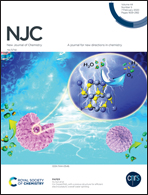A composite of ultra-fine few-layer MoS2 structures embedded on N,P-co-doped bio-carbon for high-performance sodium-ion batteries†
Abstract
A sustainable and easy method for the fabrication of a composite of ultra-fine few-layer MoS2 structures embedded on N,P-co-doped bio-carbon (MoS2-N/P-C) was developed by using natural chlorella as an adsorbent and reactor. This MoS2-N/P-C composite was easily synthesized by carrying out a biosorption of chlorella and a subsequent calcination process. This bio-carbon made from chlorella acted as a nanoreactor to prevent the MoS2 nanoparticles from agglomerating with each other during the calcination process. Besides, the N,P-codoped bio-carbon contributed to the relatively high conductivity and surface wettability of this composite and accommodated the large radius of Na+. When used as an anode for sodium ion batteries, it showed significant superiority with a high rate and long-duration cycling performance, evidenced by a measured capacity of 175 mA h g−1 after 2000 cycles at 5 A g−1.



 Please wait while we load your content...
Please wait while we load your content...